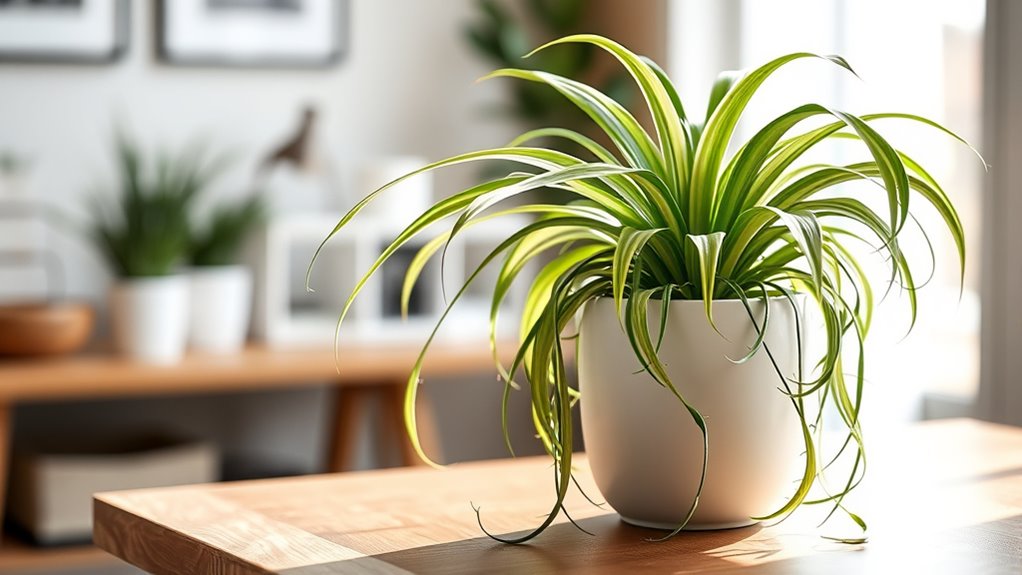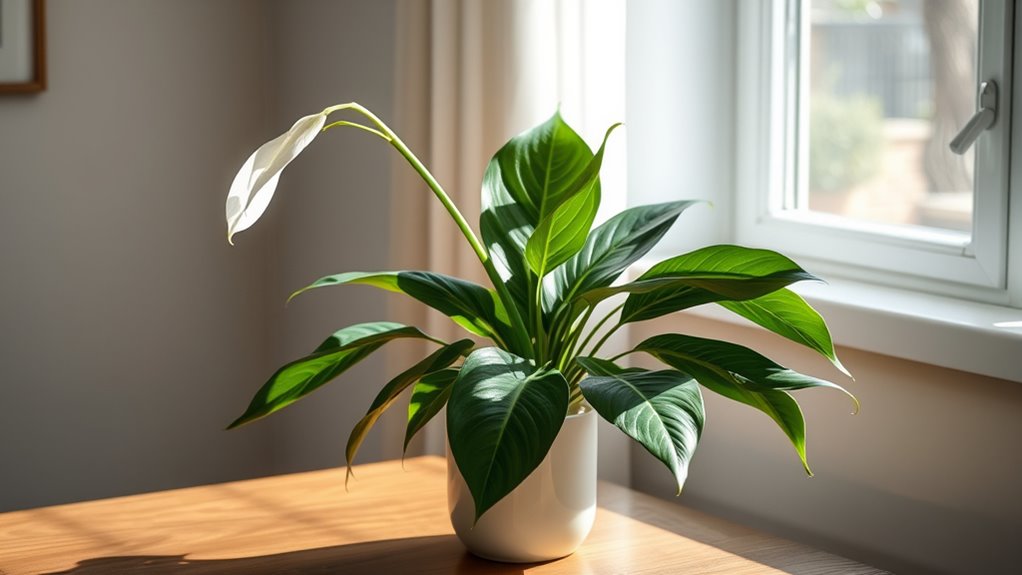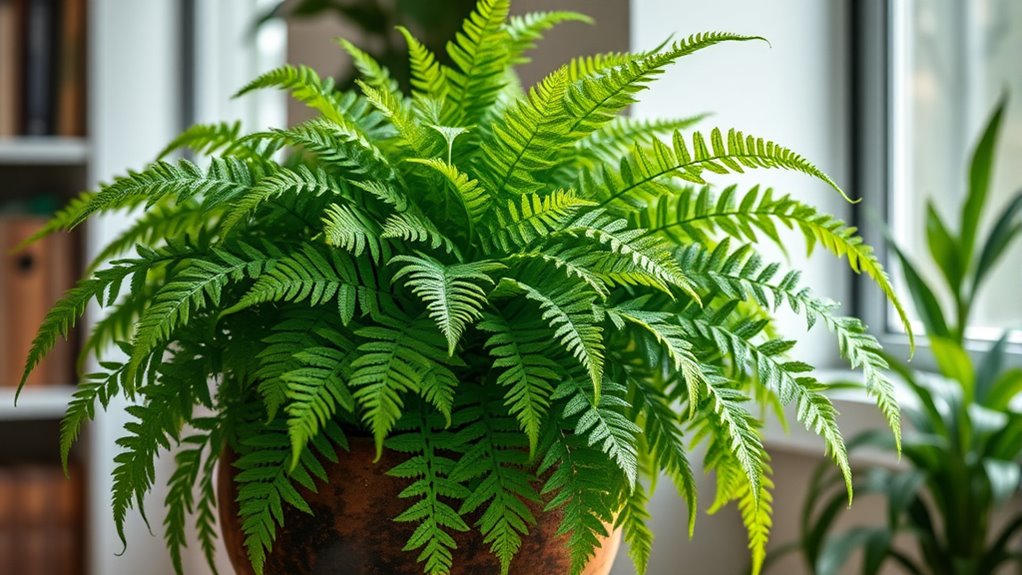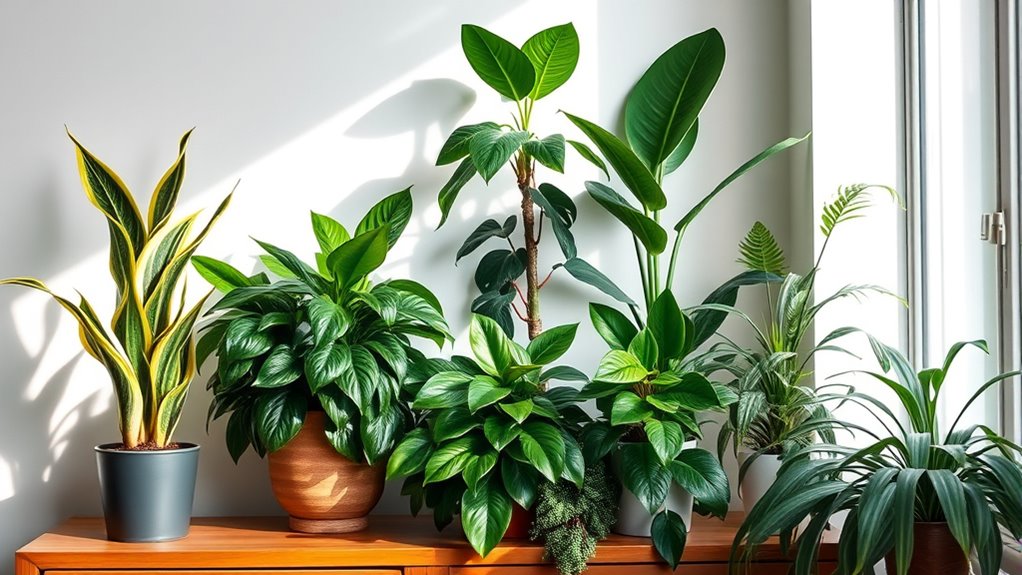If you want indoor plants that clean the air better than any filter, start with the Spider Plant, Snake Plant, Peace Lily, Boston Fern, Rubber Plant, and English Ivy. These plants remove toxins like formaldehyde, benzene, and VOCs while adding humidity and beauty. They require minimal maintenance and work passively to improve your environment. Want to see how each plant can transform your space? Keep exploring for all the details.
Key Takeaways
- Plants like the Snake Plant and Rubber Plant passively absorb formaldehyde, benzene, and xylene more effectively than many air filters.
- Spider Plant and English Ivy remove VOCs and mold spores, enhancing indoor air quality beyond standard filtration methods.
- Boston Fern boosts humidity and filters toxins, improving air quality naturally without mechanical filters.
- Many low-maintenance indoor plants actively detoxify air through natural gas exchange and absorption.
- Studies, including NASA research, confirm certain plants outperform HEPA filters at removing airborne toxins.
Spider Plant: The Versatile Air Cleanser

If you’re looking for an easy-to-maintain plant that improves indoor air quality, the Spider Plant is an excellent choice. This resilient indoor plant excels at air purification by removing formaldehyde, benzene, xylene, and other VOCs. Its natural ability to act as a low-maintenance air filter makes it popular among indoor plant enthusiasts. A single Spider Plant can clean the air in a 200-square-foot room, offering efficient indoor air quality enhancement. It produces offshoots, or pups, which you can propagate to expand your natural air purification system effortlessly. Thriving in bright to moderate indirect light and tolerating irregular watering, the Spider Plant is perfect for busy households seeking healthier indoor air without hassle. Additionally, integrating AI-powered analysis can help monitor and optimize the plant’s health for even better air purification results.
Snake Plant: The Low-Maintenance Toxin Eliminator

The Snake Plant is a powerhouse for removing toxins like formaldehyde, benzene, and xylene from your indoor air. It’s incredibly easy to care for, tolerating low light and infrequent watering, perfect for busy or beginner gardeners. Plus, it helps improve air quality around the clock by releasing oxygen at night. Its ability to naturally filter indoor air is supported by research into air purification technologies and plant-based solutions. Additionally, the Snake Plant’s resilience makes it an ideal choice for low-maintenance enthusiasts who want a low-maintenance plant that contributes to a healthier environment. Its capacity to enhance indoor air quality is comparable to some HEPA filters, making it a natural alternative for improving your living space. Incorporating such indoor plants into your environment can also boost overall well-being and reduce stress.
Toxin Removal Efficiency
The Snake Plant stands out as one of the most efficient indoor plants for removing toxins from the air. Its air purifying abilities target volatile organic compounds like formaldehyde, benzene, and xylene, making it highly effective at toxin removal. Through passive detoxification, it absorbs pollutants even in low light conditions, which means it continuously improves indoor air quality without requiring much effort. The plant’s pollutant absorption process involves natural gas exchange, providing ongoing, natural filtration. Unlike filters that need replacing, the Snake Plant’s toxin removal capacity is consistent and sustainable. Its ability to eliminate multiple VOCs while thriving in low light makes it a low-maintenance, high-performance addition to any indoor space seeking cleaner, healthier air. Additionally, understanding the AI’s role in environmental monitoring can help optimize the use of plants like the Snake Plant for better air quality management. Incorporating plant-based air purification strategies can further enhance indoor environments and reduce reliance on mechanical filters. Moreover, research indicates that the air purification capabilities of such plants can be amplified through thoughtful placement and care practices, leveraging the benefits of indoor environmental control to maximize health benefits. A comprehensive approach that combines plant selection with environmental awareness can significantly improve indoor air quality over time.
Easy Care Requirements
When considering indoor plants for air purification, ease of care plays a significant role in long-term success. The Snake Plant excels as an easy care, low-maintenance choice that offers reliable indoor air purification. Its low light tolerance means you can place it nearly anywhere, from dim corners to brighter spots, without stressing the plant. As a hardy plant, it’s neglect tolerant and can handle irregular watering—about once every 2-6 weeks—making it perfect for busy or forgetful plant owners. Its slow growth reduces the need for frequent pruning or fertilizing, while its indoor climate adaptability allows it to withstand temperature fluctuations effortlessly. Its resilience ensures it remains healthy and effective in various environments over time. Additionally, its rampant adaptability to various indoor environments ensures it remains resilient and effective over time. A low-maintenance plant like the Snake Plant is especially suitable for those new to indoor gardening or with busy schedules. Proper hydration and nutrition are essential for maintaining its health and maximizing its air-purifying benefits, especially in indoor settings.
Peace Lily: The Elegant Pollutant Remover

If you’re looking to improve indoor air quality effortlessly, the Peace Lily stands out as an elegant and effective solution. This popular indoor plant excels in air purification by filtering out airborne toxins like benzene, formaldehyde, and trichloroethylene. Its toxin filtering abilities make it one of the best natural air purifiers among low light plants, thriving in indirect, medium-to-low light conditions. The lush foliage and striking white flowers add aesthetic appeal while actively cleaning the air around you. Keep in mind, the Peace Lily is toxic to pets and humans if ingested, so it’s best to place it out of reach. Additionally, regular watering and maintenance can help maintain its health and air purifying capabilities. Proper plant care includes monitoring soil moisture and avoiding overwatering, which can impact its ability to filter pollutants effectively. With its beauty and air-cleaning power, this plant is an ideal choice for enhancing your indoor environment.
Boston Fern: The Humidity-Boosting Filter

Ever wondered how to naturally boost indoor humidity while purifying the air? The Boston Fern is your answer. This lush indoor plant excels at air purification, removing pollutants like benzene, toluene, and xylene. Plus, its high transpiration rate markedly increases indoor humidity, making your environment more comfortable. To visualize, consider this setup:
| Plant | Key Benefit | Care Tip |
|---|---|---|
| Boston Fern | Humidity boost & air purification | Keep soil moist, mist regularly |
| Nearby humidifier | Enhances moisture levels | Place close for synergy |
| Indoor air quality | Improved with transpiration | Avoid direct sunlight |
With proper plant care, your Boston Fern will improve indoor air quality while increasing moisture, reducing respiratory irritation, and creating a healthier space. HEPA filters are highly effective at capturing airborne particles, so combining your plant with an air purifier can maximize benefits. Additionally, maintaining optimal soil moisture ensures your fern remains healthy and continues to purify the air effectively. Incorporating vibrational energy principles from the Law of Attraction can also enhance your environment’s overall harmony and wellness. Engaging in mindful practices like meditation can further amplify the spiritual benefits of your indoor space, promoting overall well-being. Creating a balanced environment with proper humidity levels can significantly support respiratory health and comfort.
Rubber Plant: The Formaldehyde Fighter

The Rubber Plant is a top choice for removing formaldehyde from your indoor air, thanks to its large, thick leaves that absorb toxins efficiently. It’s also easy to care for, tolerating low light and cooler temperatures with minimal fuss. Regular watering keeps it healthy and at its best for air purification. Its popularity is reflected in many user reviews, which highlight its effectiveness and aesthetic appeal.
Formaldehyde Absorption Efficiency
Did you know that the Rubber Plant (Ficus elastica) is one of the most effective natural solutions for removing formaldehyde from indoor air? Its high absorption efficiency makes it stand out among air purifying plants. The large, thick leaves actively absorb formaldehyde molecules through surface contact and internal processes, transforming them into less harmful substances. NASA studies confirm that rubber plants can markedly improve indoor air quality, often outperforming standard air purifiers in formaldehyde removal. As a natural air cleaning option, the Rubber Plant offers excellent air filtering capabilities for homes and offices. Its ability to tolerate low light and cooler temperatures further enhances its role as a houseplant dedicated to maintaining healthier indoor environments, making it a top choice for natural air filtering and formaldehyde mitigation.
Easy Indoor Maintenance
Maintaining a Rubber Plant is straightforward, making it an excellent choice for those seeking effective air purification without extra effort. Its easy care and low maintenance needs mean you don’t have to worry about complex routines. The plant tolerates low light and cooler temperatures, fitting well into indoor environments with limited sunlight. Its hardy nature and glossy leaves provide a large surface area for air purification, helping improve indoor air quality by absorbing indoor air toxins like formaldehyde. A simple watering schedule of every 1-2 weeks keeps your Rubber Plant healthy and maximizes its pollutant absorption. With minimal fuss, this plant offers consistent air quality improvement, making it perfect for anyone seeking low-light-tolerance, low-maintenance greenery that enhances their indoor space.
English Ivy: The Trailing Toxin Absorber

English Ivy (Hedera helix) stands out as a highly effective natural air purifier, especially for removing common indoor toxins like formaldehyde, benzene, and xylene. As one of the top indoor plants for air purification, it excels at pollutant removal through VOC filtering, improving indoor air quality. Its trailing vines are perfect for adding aesthetic appeal while actively reducing airborne toxins. NASA’s research highlights English Ivy’s ability to filter out harmful VOCs and mold spores, making it a valuable addition to any home. This houseplant not only enhances air quality but also contributes to a healthier living environment. Just remember, while English Ivy is effective at toxin absorption, it’s toxic to pets and children, so place it safely away from little ones and furry friends.
Frequently Asked Questions
Which House Plant Purifies the Air the Most?
You’re wondering which house plant purifies the air the most. The Snake Plant stands out because it effectively removes formaldehyde, benzene, and xylene, making it a top choice. Its low maintenance and ability to thrive in various light conditions add to its appeal. By placing a Snake Plant in your space, you actively improve air quality, creating a healthier environment without relying on traditional filters.
What Plant Removes 78% of Airborne Mold?
You might wonder which plant removes 78% of airborne mold. It’s English Ivy (Hedera helix). Studies show it’s highly effective at filtering mold spores, especially near damp areas like bathrooms or basements. Its trailing growth and large leaves trap mold particles from the air, making it a natural and powerful air purifier. Proper placement and maintenance boost its mold-removing capabilities, helping keep your indoor air cleaner naturally.
What Plant Is NASA Recommend for Air Purifiers?
You’re wondering which plant NASA recommends for air purification. The Peace Lily (Spathiphyllum) stands out, as it effectively filters out multiple toxins like benzene, formaldehyde, and trichloroethylene. It’s easy to care for and beautifies your space while improving air quality. If you want a natural, reliable air purifier, the Peace Lily is your best choice, according to NASA’s research.
What Plants Are Good for Clearing the Air?
You’re curious about plants that clear the air**? Did you know that some, like the snake plant and peace lily, can remove up to 90% of specific toxins? You’ll find that plants such as English ivy and spider plants excel at eliminating mold spores and VOCs**, often outperforming filters. By choosing these, you’re not just decorating—you’re actively improving your indoor air quality naturally and effectively.
Conclusion
By bringing these indoor plants into your space, you invite a gentle gust of freshness that quietly enhances your environment. Their natural charm and subtle cleansing abilities work harmoniously, creating a healthier, more inviting atmosphere without any fuss. Embrace these green companions to subtly elevate your daily life, turning your home into a serene haven. In their quiet presence, you’ll find a simple, soothing way to breathe easier every day.









